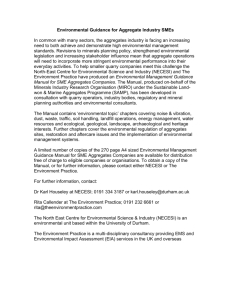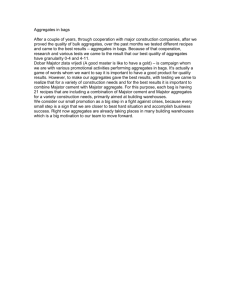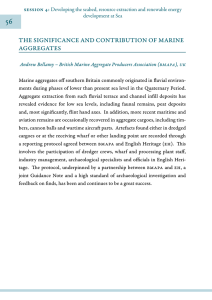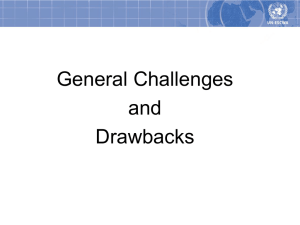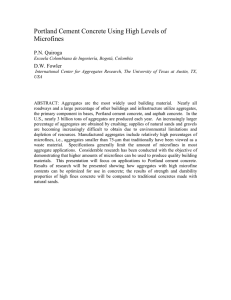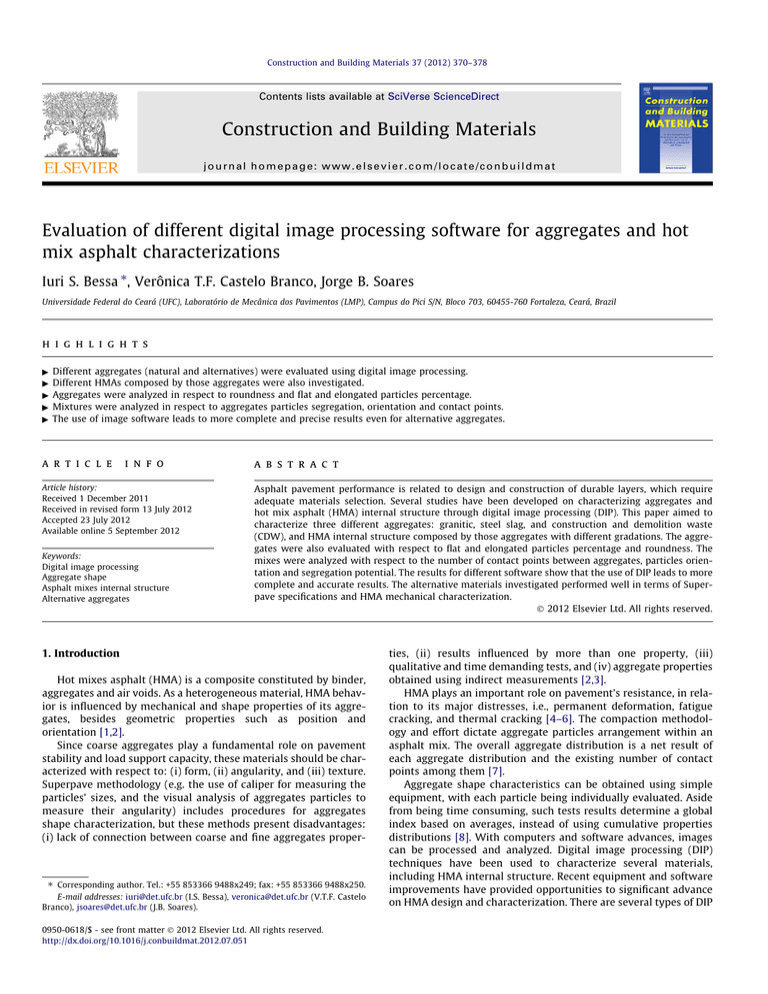
Construction and Building Materials 37 (2012) 370–378
Contents lists available at SciVerse ScienceDirect
Construction and Building Materials
journal homepage: www.elsevier.com/locate/conbuildmat
Evaluation of different digital image processing software for aggregates and hot
mix asphalt characterizations
Iuri S. Bessa ⇑, Verônica T.F. Castelo Branco, Jorge B. Soares
Universidade Federal do Ceará (UFC), Laboratório de Mecânica dos Pavimentos (LMP), Campus do Pici S/N, Bloco 703, 60455-760 Fortaleza, Ceará, Brazil
h i g h l i g h t s
" Different aggregates (natural and alternatives) were evaluated using digital image processing.
" Different HMAs composed by those aggregates were also investigated.
" Aggregates were analyzed in respect to roundness and flat and elongated particles percentage.
" Mixtures were analyzed in respect to aggregates particles segregation, orientation and contact points.
" The use of image software leads to more complete and precise results even for alternative aggregates.
a r t i c l e
i n f o
Article history:
Received 1 December 2011
Received in revised form 13 July 2012
Accepted 23 July 2012
Available online 5 September 2012
Keywords:
Digital image processing
Aggregate shape
Asphalt mixes internal structure
Alternative aggregates
a b s t r a c t
Asphalt pavement performance is related to design and construction of durable layers, which require
adequate materials selection. Several studies have been developed on characterizing aggregates and
hot mix asphalt (HMA) internal structure through digital image processing (DIP). This paper aimed to
characterize three different aggregates: granitic, steel slag, and construction and demolition waste
(CDW), and HMA internal structure composed by those aggregates with different gradations. The aggregates were also evaluated with respect to flat and elongated particles percentage and roundness. The
mixes were analyzed with respect to the number of contact points between aggregates, particles orientation and segregation potential. The results for different software show that the use of DIP leads to more
complete and accurate results. The alternative materials investigated performed well in terms of Superpave specifications and HMA mechanical characterization.
Ó 2012 Elsevier Ltd. All rights reserved.
1. Introduction
Hot mixes asphalt (HMA) is a composite constituted by binder,
aggregates and air voids. As a heterogeneous material, HMA behavior is influenced by mechanical and shape properties of its aggregates, besides geometric properties such as position and
orientation [1,2].
Since coarse aggregates play a fundamental role on pavement
stability and load support capacity, these materials should be characterized with respect to: (i) form, (ii) angularity, and (iii) texture.
Superpave methodology (e.g. the use of caliper for measuring the
particles’ sizes, and the visual analysis of aggregates particles to
measure their angularity) includes procedures for aggregates
shape characterization, but these methods present disadvantages:
(i) lack of connection between coarse and fine aggregates proper-
⇑ Corresponding author. Tel.: +55 853366 9488x249; fax: +55 853366 9488x250.
E-mail addresses: iuri@det.ufc.br (I.S. Bessa), veronica@det.ufc.br (V.T.F. Castelo
Branco), jsoares@det.ufc.br (J.B. Soares).
0950-0618/$ - see front matter Ó 2012 Elsevier Ltd. All rights reserved.
http://dx.doi.org/10.1016/j.conbuildmat.2012.07.051
ties, (ii) results influenced by more than one property, (iii)
qualitative and time demanding tests, and (iv) aggregate properties
obtained using indirect measurements [2,3].
HMA plays an important role on pavement’s resistance, in relation to its major distresses, i.e., permanent deformation, fatigue
cracking, and thermal cracking [4–6]. The compaction methodology and effort dictate aggregate particles arrangement within an
asphalt mix. The overall aggregate distribution is a net result of
each aggregate distribution and the existing number of contact
points among them [7].
Aggregate shape characteristics can be obtained using simple
equipment, with each particle being individually evaluated. Aside
from being time consuming, such tests results determine a global
index based on averages, instead of using cumulative properties
distributions [8]. With computers and software advances, images
can be processed and analyzed. Digital image processing (DIP)
techniques have been used to characterize several materials,
including HMA internal structure. Recent equipment and software
improvements have provided opportunities to significant advance
on HMA design and characterization. There are several types of DIP
I.S. Bessa et al. / Construction and Building Materials 37 (2012) 370–378
methodologies, using equipment such as the aggregate measurement image system (AIMS) and the X-ray tomography.
This work aims to analyze different aggregates (granitic, construction and demolition waste – CDW, and steel slag), using a planar DIP technique, in relation to some of its shape properties
(percentage of flat and elongated particles, and angularity). The
technique requires simple equipment, besides being fast. It also
aims to characterize different HMAs (dense-graded and stone matrix asphalt – SMA) internal structure: (i) contact points; (ii) segregation potential, and (iii) particle orientation. Two different
software were used: (i) ImageTool and (ii) Digital Image Analysis
System. The dense-mixes were produced using the three distinct
aggregates. The SMA mix was produced using only with granitic
aggregates. The mixes were compacted using: the Superpave gyratory compactor (SGC), and a slab compactor, developed by the
Institut français des sciences et technologies des transports, de
l’aménagement et des réseaux (IFSTTAR).
2. Aggregate shape properties and HMA internal structure
characterization
2.1. Aggregate shape properties
Aggregates in asphalt mixes represent approximately 90–95%,
by weight. According to Superpave specifications, their properties
were classified as consensus (angularity for coarse and fine aggregates, amount of flat and elongated particles and plastic fines) and
source (abrasion resistance, sanity and deleterious materials determination) [9].
In order to determine if the particles are flat or elongated (ASTM
D 4791/99) two ratios need to be observed: (i) aggregate length to
width, and (ii) aggregate width to thickness. This procedure requires a special caliper that provides the mentioned ratios for each
particle. Flat and/or elongated aggregates in asphalt mixes can
break decreasing workability during compaction, and under traffic.
Superpave specifications suggest aggregate shape evaluation with
respect to its flat and elongated particles using the ratio 5:1. Up
to 10% of flat/elongated particles is admitted for traffic volume from
medium to high (Equivalent Single Axle Loads (ESALs) > 3 106).
Angularity is associated to the level of variations at the aggregates’ corners. This shape parameter is related to the superficial
texture and can guarantee a high level of internal friction between
aggregates, and influence HMA rutting resistance. Manual observation of each particle is required to verify the existence of fractured
faces. However, this test does not evaluate angularity level (sharpness) or texture [10]. Superpave specifications indicate the minimum value for fractured faces according to the traffic or to the
proximity of the layer to the surface.
2.2. HMA internal structure
The occurrence of a contact point between two aggregates is
established when they are separated from each other at a fixed
maximum distance. Fig. 1a shows a scheme of a contact between
two aggregates particles. There is a relationship between HMA
strength resistance and the number of contact points. Tashman
et al. [11] concluded that the number of contacts points between
aggregates depends on the parameters (angle, pressure, temperature and height) used in the compaction. Sousa et al. [12] showed
that samples produced using the kneading compactor have higher
number of contact points and higher resistance to permanent
deformation, when compared to those produced by other compaction methods.
The orientation of an aggregate particle is the angle between
the particle major axis and the horizontal line on a digitalized im-
371
age (Fig. 1b). This axis is defined as the largest distance between
two points in the particle contour [1,11–14]. It is possible to quantify the aggregate directional distribution using the vector magnitude (D), according to Eq. (1).
D¼
qffiffiffiffiffiffiffiffiffiffiffiffiffiffiffiffiffiffiffiffiffiffiffiffiffiffiffiffiffiffiffiffiffiffiffiffiffiffiffiffiffiffiffiffiffiffiffiffiffiffiffi
100
2
ðR sin hk Þ þ ðR cos hk Þ2
N
ð1Þ
where D: vector magnitude; hk: angle between the aggregate particle and the horizontal line and N: number of aggregates particles
analyzed in the image.
The vector magnitude describes the aggregate particles preferential orientation. It varies from 0% to 100%. 0% represents a completely random particles distribution. 100% shows that aggregates
are aligned exactly in the same direction [1,15]. According to Tashman et al. [16], anisotropy is caused by the microstructure constituents’ non-uniform distribution. Anisotropic materials have their
mechanical properties depending on its particles direction. Masad
et al. [1] verified that increasing the compaction effort (up to 100
gyrations), there is a tendency to form a more uniform orientation.
For numbers of gyrations higher than 100, the aggregate structure
presents a more random orientation. HMA internal structure for
samples compacted using the SGC and extracted from the field
were compared. Those authors concluded that, to achieve the same
orientation level existing in the field, a higher number of gyrations
was necessary. The air void content found for the field samples was
obtained in the laboratory with 25 gyrations, but the vector magnitude was obtained with 100 gyrations.
Hunter et al. [17] concluded that the particles orientation must
be induced by the confining boundary conditions. Findings from
the same study showed that samples produced using slab compactors lead to aggregates with a smaller orientation angle. This results in lower resistance to permanent deformation, when
compared to other compaction methods, such as gyratory or vibratory. Zhang et al. [18] showed that SGC samples have a more uniform orientation, or, higher vector magnitude, in comparison to
vibratory compactor samples.
HMA segregation can be defined as a lack of homogeneity between its constituents in a certain level that can accelerate pavement distresses [19]. Fig. 1c shows a transversal specimen
section, with three segregation groups. Ideally, a dense-mix must
have a uniform aggregates distribution. Gyratory and vibratory
compaction methods induce to a higher segregation level when
compared to the plate fabrication method [17].
Masad et al. [1] evaluated aggregates segregation and verified
that field samples are more prone to segregation if compared to
laboratory ones. Tashman et al. [11] calculated aggregates lateral
segregation, or radial distribution, and concluded that coarse
aggregates tend to be located on the external area of the SGC specimen horizontal section. Hunter et al. [17] concluded that the
vibratory compaction induces particles migration to the specimen
boundaries, while slab compaction may induce to a lower segregation level.
2.3. Digital image processing (DIP) techniques
The difficulties faced during aggregates and HMA internal structure characterizations have encouraged the DIP use. Different DIP
methods have been used in the past few years. The aggregate imaging measurement system (AIMS), equipment distributed by Pine
Instrument Company, can be used to capture and to analyze aggregates with different sizes. The X-ray tomography is a non-destructive technique for 3D analysis [20]. The simplest DIP technique
involves the digitalization of a real planar image and the analysis
of its components to obtain parameters related to aggregates shape
372
I.S. Bessa et al. / Construction and Building Materials 37 (2012) 370–378
Fig. 1. (a) Contact between aggregates, (b) aggregate particles orientation, and (c) segregation groups.
and orientation. Some researchers used this technique for pavement materials characterization [1,7,14,21,22].
There are several software such as: ImageTool (developed by
the Department of Dental Diagnostic Science at the University of
Texas Health Science Center), ImageJ (developed by the National
Institutes of Health), the Digital Image Analysis System (developed
by the University of Wisconsin-Madison) and Abaqus 2008, that
can be used to perform image analyzes. The process using image
software requires the digitalization of a real image and the analysis
of its components to obtain parameters related to aggregates shape
and orientation.
There are four steps involved in DIP: (i) digitalization, which
transforms a real image into a digital one, (ii) enhancement, when
the aggregates get to be more clearly differentiated one from another
detecting aggregates boundaries, (iii) restoration, performed to correct the imperfections that may appear during the first process, and
(iv) segmentation, an identification procedure that labels the regions
or objects inside an image, detecting its edges. The last step allows the
image subdivision into smaller parts, so that they can be identified
and treated separately [23]. The subdivision level must be defined
according to the objects’ colors supposed to be characterized [24]. If
an image can be identified it is possible to determine properties such
as: (i) area, (ii) perimeter, (iii) orientation, and (iv) shape.
DIP allows easy access to aggregate shape characteristics, leading to more precise and realistic parameters determination [25].
Aggregate sphericity and orientation can be determined. Sphericity
can be measured through a parameter called roundness (Eq. (2))
that ranges from 0 to 1. A value closer to 1 indicates a more circular
object. If the result of the analyses is 1, the object would resemble a
perfect circle.
r¼
4pA
P2
ð2Þ
where r: roundness; A: surface area; and P: perimeter of an isolated
aggregate particle.
The aggregates’ arrangement, directional distributions, and contact points, forms the mineral skeleton. These distributions result
Fig. 2. Gradation curves and specifications limit.
373
I.S. Bessa et al. / Construction and Building Materials 37 (2012) 370–378
Table 1
Mix design parameters (100 gyrations).
Parameters/mix
HMA
Binder (%)
Voids (%)
Gmm
SMA
Mix I (100% granitic)
Mix II (50% CDW)
Mix III (50% steel slag)
Mix IV [29] (100% granitic)
6.0
4.0
2.400
6.9
4.0
2.322
6.6
4.0
2.732
7.2
3.2
2.323
Table 2
Volumetric parameters: slab specimens.
Parameters/
mix
HMA
Mix I (100%
granitic)
Mix II (50%
CDW)
Mix III (50% steel
slag)
Voids (%)
CV (%)
7.4
5.2
2.7
11.4
3.6
17.1
from the materials proportions and the compaction method. HMA
microstructure has been associated to its mechanical properties
[2,7].
The Digital Image Analysis System can be used to determine
aggregate orientation, segregation level, and contact points in an
asphalt mix. The sample preparation procedure involves sawing a
compacted specimen. The specimen faces are scanned in 2D. Image
treatment and transformation processes are performed, leading to
the parameters for the analysis [26]. Similar procedure can be use
to determine aggregate orientation with the use of ImageTool.
3. Material and methods
3.1. Aggregates and binder
The aggregates used were: (i) granitic; (ii) CDW; and (iii) steel slag. Aggregate
characterization was performed using Brazilian standard procedures. One of the tests
performed was the shape index (as described on the standard DNER-ME 086/94),
which results into a value the ranges from 0 to 1. A value of 1 means that the aggregate particle is a perfect cube. The results were 0.66 for granitic, 0.85 for CDW and
0.80 for steel slag. The binder used was a conventional non-modified asphalt cement
(AC) produced by Petrobras, classified by penetration as an AC 50/70 [27].
3.2. HMA design
HMAs were designed following the Superpave methodology with 100 gyrations.
Mixes were also compacted using the LCPC compactor. The SMA mix was compacted only in the SGC. The dense-graded mixes were compacted with different
aggregates: (i) mix I – granitic aggregates, (ii) mix II – 50% of CDW and 50% of granitic aggregates, and (iii) mix III – 50% of steel slag and 50% of granitic aggregates.
Mix IV, a ½’’ SMA, was composed only by granitic aggregates. Fig. 2 shows the mixes
gradation curves.
To produce the specimens, the binder was heated at 165 °C and the aggregates
at 175 °C. The mixes were short term aged for 2 h at 150 °C. With Superpave design
results, slabs (500 180 50 mm) were produced in the LCPC compactor. Slabs
compaction was done following French specifications [28]. Table 1 shows the mixes
design parameters. Cylindrical specimens were extracted from the central part of
the slabs. Table 2 presents the volumetric parameters (mean average and Coefficient of Variation – CV) for 12 specimens, for each mix. Besides the volumetric
parameters, HMA were characterized using resilient modulus (RM) and indirect
Fig. 3. Aggregates set to be analyzed: (a) granitic, (b) steel slag, and (c) construction
and demolition waste (CDW).
tensile strength (ITS) tests. The procedures for these tests are described, respectively, on Brazilian standards, DNER-ME 133/94 and DNER-ME 138/94. Table 3 presents the results obtained for each mix.
Table 3
Mechanical test results.
Properties/mix
Superpave giratory compactor (SGC)
LCPC compactor
HMA
RM (MPa)
ITS (MPa)
SMA [29]
HMA
Mix I
Mix II
Mix III
Mix IV
Mix I
Mix II
Mix III
2224
0.83
2935
0.99
2241
0.84
3790
1.11
2683
0.94
2922
1.01
2876
1.05
374
I.S. Bessa et al. / Construction and Building Materials 37 (2012) 370–378
Fig. 4. Cuts on the specimens for the analyses – cut AA (horizontal) and cut BB
(vertical): (a) scheme, and (b) pictures of the specimens.
3.3. Aggregates shape characterization
The percentage of flat/elongated particles was determined for coarse aggregates
[30]. According to Superpave, an aggregate particle is considered flat or elongated
when its greater dimension is, at least, five times bigger than its smaller one. The
angularity test was performed according to ASTM D 5821/01 [31].
3.4. Digital image processing (DIP) procedures
3.4.1. Aggregates characterization
Parameters related to aggregate shape (percentage of flat/elongated particles
and angularity) were also obtained using DIP techniques. A picture of the aggregates
disposed on a plane surface was taken by and analyzed. The process of taking the pictures was done by using a five mega pixels portable digital camera, and there was no
specific lighting consideration through the process. The pictures were transformed
into gray scale images and passed through: enhancement, restoration, segmentation, and border detection. The objects of the images were identified and analyzed
using ImageTool software. Aggregates were disposed in a way such that the bigger
and the smaller face of each particle could be obtained (Fig. 3). The particles number
was about 77, approximately the same amount used during AIMS analysis.
3.4.2. HMA internal structure characterization
HMA internal structure was analyzed in respect to: (i) contact points; (ii) particles orientation; and (iii) radial segregation. The specimens were sawed in two
locations: (i) at one third from the top and (ii) at one third from the bottom, as
shown in Fig. 4. Two compaction methods (IFSTTAR compactor and SGC) and directions (horizontal and vertical) were evaluated. After sawing, each specimen face
was digitalized, and the DIP procedure was applied (Fig. 5). Two different software,
ImageTool and Digital Image Analysis System, were used.
To use the Digital Image Analysis System a few steps had to be followed according to [26]. First, the lower size of the visible aggregate on the image was identified.
After that, some image filters were used to remove imperfections and to decrease the
variation of the pixels intensity (providing a uniform grey scale image). As the third
and fourth steps, the image passes through a boundary detection process, where
aggregates could be defined inside the image, and it was transformed into a black
and white picture, to differentiate aggregate from mastic. Results were automatically generated. For the contact points, the software provided the number of times
that it could be identified any aggregate–aggregate contact – when two aggregates
were separated by 0.5 mm or less. For aggregate orientation, the angles between
each particle and the horizontal axis were plotted in frequency histograms. For
the segregation, the number of aggregates particles found in each of the radial regions (Fig. 1c) was defined for each aggregate size. The use of ImageTool requires
the same steps used for the other software, which was described above. The major
difference is that, for this paper, there was only one parameter for the HMA internal
structure analyzed by ImageTool, which was the aggregate orientation.
Fig. 5. Steps for DIP: (a) digitalized image, (b) image transformed on grey scale, and
(c) borders’ detection.
4. Results and discussion
4.1. Aggregates shape characterization
4.1.1. Percentage of flat/elongated particles
The percentages of flat/elongated particles for the aggregates
were determined through images analysis. Fig. 6 presents the
results obtained using ImageTool software. The manual test to
determine the amount of flag/elongated particles provides realistic
values due to the possibility to measure the length of any of the
aggregate directions, but it demands too much time, because the
particles must be analyzed one by one. There was a notable differ-
375
I.S. Bessa et al. / Construction and Building Materials 37 (2012) 370–378
ence between the values obtained in the laboratory, using the caliper, and the ones from the DIP. Aggregate pictures were taken in
2D. The third dimension (aggregate depth) cannot be seen and
measured by ImageTool. Therefore, the use of AIMS would bring
more realistic values for flat/elongated particles determination.
Nevertheless, the methodology involving ImageTool has a very
low cost and can provide real ratios values.
The aggregates investigated match Superpave criteria in terms
of flat and elongated particles (less than 10% above 1:5). The granitic aggregate tends to be more flat/elongated than the alternative
ones. The frequency of granitic aggregates that have their dimension on the 1:2 proportion was, approximately, twice the other
aggregates’ frequencies. The use of alternative aggregates can produce mixes with better resistance during compaction.
4.1.2. Angularity and roundness
Angularity results provided the number of fractures faces for
each aggregate (Fig. 7). The results were compared to roundness.
The lower the number of fractured faces, the higher is the aggregate roundness. The aggregates met Superpave specification for
every traffic/pavement thickness combination, except the granitic,
which has almost 60% of its particles with one fractured face. Fig. 8
presents roundness values obtained using ImageTool software.
The granitic aggregate has a high percentage (65%) of particles
with sphericity lower than 0.6. The alternative aggregates have a
high percentage of particles with sphericity higher than 0.6 (75%
and 65% for CDW and steel slag, respectively). CDW has a great
quantity (42%) of its particles with sphericity values higher than
0.7, the closest to a sphere shape among the aggregates investigated. The values obtained using DIP are more precise and based
on statistic distributions, not only on average values.
nitic aggregates. The Digital Image Analysis System provided
aggregates orientation, contact points, and aggregates segregation.
ImageTool software provided only aggregates orientation. Only
coarse aggregates were selected due to (i) software precision,
which presents limitations on detecting fine aggregates and (ii)
coarse aggregate influence on HMA mineral skeleton.
4.2.1. Contact points
Table 4 presents the number of contact points for each mix. The
number of contacts between aggregates particles was higher (12%)
for the SMA. The specimens extracted from the slabs have a higher
level of contact points (12%), comparative to the SGC ones (mix I).
For the mixes composed by CDW (mix II), samples compacted
using both methods presented similar results. This might have
happened due to the alternative aggregate heterogeneity. The CV
values indicate that the different compaction methods produce
specimens with distinct characteristics.
4.2.2. Orientation
For aggregate orientation, the vector magnitude was calculated.
The values indicate the particles orientation uniformity within the
mixes. Table 5 shows the results using ImageTool software for horizontal and vertical specimens sections. Table 6 presents the re-
4.2. HMA internal structure analysis
With the two different software, an analysis of the internal
structure was performed for: (i) HMA specimens produced using
the CGS, one composed by granitic aggregates and another composed by CDW (50%) and granitic aggregates (50%), (ii) HMA specimens produced using the LCPC compactor, one composed by
granitic aggregates and another composed by CDW (50%) and granitic aggregates (50%), and (iii) SMA specimens composed by gra-
Fig. 7. Number of fractured faces (laboratory test).
Fig. 6. Percentage of flat/elongated particles (DIP).
Fig. 8. Roundness values (DIP).
Table 4
Number of contact points.
Contact points/mix
Superpave gyratory compactor (SGC)
HMA
Average
CV (%)
LCPC compactor
SMA
HMA
Mix I (100% granitic)
Mix II (50% CDW)
Mix IV (100% granitic)
Mix I (100% granitic)
Mix II (50% CDW)
267
15.6
279
9.3
298
3.8
298
5.8
278
5.1
376
I.S. Bessa et al. / Construction and Building Materials 37 (2012) 370–378
Table 5
Vector magnitude values (horizontal and vertical sections) – ImageTool software.
Vector magnitude/mix
Section
HMA
Superpave gyratory compactor (SGC)
LCPC compactor
Mix I (100% granitic)
Mix II (50% CDW)
Mix I (100% granitic)
Mix II (50% CDW)
Average (%)
CV (%)
Horizontal
55.4
4.7
48.2
3.8
53.2
15.7
52.3
5.3
Average (%)
CV (%)
Vertical
32.0
3.0
33.8
6.5
52.8
4.1
51.6
8.0
Table 6
Vector magnitude values (horizontal section) – Digital Image Analysis System.
Vector magnitude/mix
Superpave gyratory compactor (SGC)
HMA
Average (%)
CV (%)
LCPC compactor
SMA
HMA
Mix I (100% granitic)
Mix II (50% CDW)
Mix IV (100% granitic)
Mix I (100% granitic)
Mix II (50% CDW)
20.9
12.8
23.6
27.7
24.2
22.3
22.1
15.1
24.0
13.4
sults obtained by Digital Image Analysis System for horizontal sections. This software only allows analysis on a circular image.
It can be observed that the specimens extracted from the slabs
presented similar characteristics in both directions. These materials tend to be isotropic, i.e., aggregate distributions are similar in
both directions. For SGC specimen, there was no uniformity for
the vector magnitude for both directions. Horizontal sections results were closer to the ones found for the slabs specimens. Yue
et al. [21] and Vasconcelos et al. [7] concluded that SGC samples
presented a more homogeneous distribution when compared to
Marshall ones. Mix II (containing CDW) presented results similar
to mix I. CDW and granitic aggregate mixes presented similar results even when different compaction methods were used. The
SMA mix (mix IV) presented a vector magnitude 16% higher than
the dense-graded granitic mix (mix I).
Some vector magnitude values obtained for the horizontal
direction are different when comparing both software results.
ImageTool analysis considers coarse and fine aggregates. This can
Fig. 9. Segregation for each mix (digital image analysis system): (a) mix I – 100% granitic, SGC; (b) mix II – 50% CDW, SGC; (c) mix I – 100% granitic, LCPC compactor; (d) mix II
– 50% CDW, LCPC French compactor; and (e) mix IV – 100% granitic, SGC.
I.S. Bessa et al. / Construction and Building Materials 37 (2012) 370–378
cause the issue of assuming binder and fine aggregates together as
being a single coarse aggregate particle. Also, the Digital Image
Analysis System has a better sensitivity, being more precise and
able to better mark out the edges of the aggregates to be
considered.
4.2.3. Segregation
Digital Image Analysis System was able to provide the amount
of each aggregate size at each group: (i) group 1, related to the
internal circle, with 1/3 of the specimen radius; (ii) group 2, related
to the intermediate zone, with a radius equivalent to 2/3 of the
specimen radius; and (iii) group 3, related to the external border,
with the specimen full radius (Fig. 3). The software considered
the aggregates retained on four sieves: No. 4, 3/800 , 1/200 and 3/400 .
The results are presented in Fig. 9.
It is possible to conclude that the SGC generated mixes with
aggregates that are more segregated, i.e., distributed in a less uniform way along the three groups, especially for the SMA one. Comparing different compaction methods, LCPC compactor mixes
presented lower segregation.
The results in this research are similar to the ones found by
Tashman et al. [11] and Hunter et al. [17], who concluded that
there must be more segregation on SGC mixes. It is important to
state that Masad et al. [1] found opposite results, which indicate
that there is no clear tendency in relation to aggregates
segregation.
5. Conclusions
This paper aimed to characterize aggregates (conventional and
alternatives) and their distribution within asphalt mixes using
DIP techniques. Manual laboratory tests were also performed in order to compare the results with those obtained through DIP. It was
shown that DIP characterization is easier and faster. Image analysis
can provide results more precise than those obtained from lab
tests, with respect to shape parameters. Laboratory tests present
average values while images analyses present statistical distributions for each parameter. Roundness results obtained using DIP
show the same tendency obtained in the laboratory. In respect to
the used software, ImageTool was able to characterize aggregates
particles shape and orientation, and the Digital Image Analysis System only captures the parameters that are related to HMA internal
structural, which includes segregation, orientation and contact
points. The granitic aggregate presented roundness values lower
than the ones from steel slag and CDW. This indicates a better
interlock when the natural aggregates are used. The SMA mix
aggregate particles presented higher contact points than the conventional dense-graded mix, which is expected, since SMAs have
a higher amount of coarse aggregates. Regarding aggregates orientation after compaction, the aggregates distribution and orientation were very similar for both dense-graded and SMA mixes.
With respect to angular orientation, the compaction methods did
not present relevant influence. When comparing mixes composed
only by granitic aggregates with mixes composed also by CDW, it
can be stated that this residue does not affect the HMA structure
in terms of aggregates distribution. The SGC mixes segregation
was greater compared to the LCPC compactor ones. For the specimens extracted from the slabs, lower segregation was obtained.
Acknowledgements
The authors thank CNPq (Conselho Nacional de Desenvolvimento Científico e Tecnológico) for supporting this research; LTP/USP
(Laboratório de Tecnologia de Pavimentos/USP) for the slabs
compaction; and Professors Hussain Bahia at the University of
377
Wisconsin-Madison and Enad Mahmoud at the Bradley University
for providing references and software.
References
[1] Masad E, Muhunthan B, Shashidhar N, Harman T. Effect of compaction
procedure on the aggregate structure in asphalt concrete. Manuscript No.
991052. Transportation Research Board; 1999.
[2] Souza LT. Investigation of aggregate angularity effects on asphalt concrete
mixture performance using experimental and virtual asphalt samples. M.Sc.
thesis. Lincoln (NE): UNL; 2009.
[3] Castelo Branco VTF, Masad E, Little DN, Soares JB, Motta LMG. Caracterização
de forma, angularidade e textura de agregado de brita granítica e escórias de
aciaria usando o Aggregate Imaging System (AIMS) In: XX Congresso de
Pesquisa e Ensino em Transportes – ANPET, Brasília; 2006. p. 1303–14 [in
Portuguese].
[4] Monismith CL. Summary report on permanent deformation in asphalt
concrete. SHRP-A/lr-91-104. Washington (DC): National Research Council;
1991.
[5] Vinson TS, Janoo VC, Haas RCG. Summary report low temperature and thermal
fatigue cracking. SHRP-A/IR-90-001. Washington (DC): National Research
Council; 1999.
[6] Bernucci LB, Motta LM, Ceratti JAP, Soares JB. Pavimentação asfáltica: formação
básica para engenheiros. 1st ed. Rio de Janeiro (RJ): Petrobras; 2007 [in
Portuguese].
[7] Vasconcelos KL, Evangelista Jr F, Soares JB. Análise da estrutura interna de
misturas asfálticas In: XVII Congresso Brasileiro de Pesquisa e Ensino em
Transportes. Recife, PE; 2005 [in Portuguese].
[8] Masad E. X-ray computed tomography of aggregates and asphalt mixes. Mater
Eval 2004:775–83.
[9] Roberts FL, Kandhal PS, Kennedy TW. Hot mix asphalt materials, mixture
design and construction. 2nd ed. Lanham (MD): National Center for Asphalt
Technology; 1996.
[10] Gouveia LT. Contribuições ao estudo da influência de propriedades de
agregados no comportamento de misturas asfálticas densas. M.Sc. thesis. São
Carlos, SP: USP; 2006 [in Portuguese].
[11] Tashman L, Masad E, Peterson B, Saleh H. Internal structure analysis of asphalt
mixes to improve the simulation of superpave gyratory to field conditions. J
Assoc Asphalt Paving Technologists 2001;70:605–55.
[12] Sousa JB, Harvey J, Painter L, Deacon JA, Monismith CL. Evaluation of laboratory
procedures for compacting asphalt – aggregate mixtures. Report No. SHRP-AUWP=91-523. Washington (DC): Strategic Highway Research Program,
National Research Council; 1991
[13] Bessa IS, Castelo Branco VTF, Soares JB. Caracterização de agregados
convencionais e alternativos utilizando técnicas de processamento digital de
imagens In: XXIII Congresso de Pesquisa e Ensino em Transportes; ANPET,
Vitória, ES; 2009 [in Portuguese].
[14] Lopes MM, Bessa IS, Castelo Branco VTF, Soares JB. Efeito do tipo de
compactação nos parâmetros volumétricos e no comportamento mecânico
de misturas asfálticas. In: 20° Encontro de Asfalto – Instituto Brasileiro de
Petróleo, Gás e Biocombustíveis, Rio de Janeiro, RJ; 2010 [in Portuguese].
[15] Masad E, Kassem E, Chowdhury A. Application of imaging technology to
improve laboratory and field compaction of HMA. The transportation research
information services TRIS; 2009. p. 250.
[16] Tashman L, Masad E, Little D, Hussein Z. A microstructure-based viscoplastic
model for asphalt concrete. Int J Plast 2004:1659–85.
[17] Hunter AE, Airey GD, Collop AC. Aggregate orientation and segregation in
laboratory-compacted asphalt samples. Transport Res Record TRB
2004;1891:8–15.
[18] Zhang L, Wang Z. Characterization of HMA internal structure using image
analysis (1968–1975). American Society of Civil Engineers; 2008.
[19] Stroup-Gardiner M, Brown ER. Segregation in hot mix asphalt pavements.
Interim report. Study No. 9–11. Washington (DC): National Cooperative
Highway Research Program, Transportation Research Board; 1998.
[20] Masad E, Jandhyala VK, Dasgupta N, Somadevan N, Shashidhar N.
Characterization of air void distribution in asphalt mixes using X-ray
computed tomography. J Mater Civil Eng 2002:122–9.
[21] Yue ZQ, Bekking W, Morin I. Application of digital image processing to
quantitative study of asphalt concrete microstructure. Transportation research
record 1492. Washington (DC):TRB, National Research Council; 1995. p. 53–
60.
[22] Evangelista Jr F, Souza LT, Soares JB. Processamento digital de imagens
aplicado à caracterização de agregados quanto à forma. In: XIX Congresso de
Pesquisa e Ensino em Transportes, ANPET, Recife, PE; 2005 [in Portuguese].
[23] Souza LT, Evangelista Jr F, Soares JB. Processamento digital de imagens
aplicado a análise micromecânica de misturas asfálticas. In: 18° Encontro de
Asfalto – IBP; Rio de Janeiro, RJ; 2006 [in Portuguese].
[24] Gonzalez RC, Woods RE. Digital image processing. Addison–Wesley; 1993.
[25] Masad E, Button JW. Unified imaging approach for measuring aggregate
angularity and texture. Comput-Aid Civil Infrastruct Eng 2000:
273–80.
[26] Mahmoud E, Kutay E, Bahia H. Digital image analysis system. In: Standard
method for determining aggregate structure in asphalt mixes by means of
planar imaging – draft procedure; 2010 <http://uwmarc.org/rilemtaskgroup2.html>.
378
I.S. Bessa et al. / Construction and Building Materials 37 (2012) 370–378
[27] ANP Resolução ANP No. 19. de 11.7.2005 DOU 12.7.2005 ‘‘Regulamento
Técnico No. 3/2005’’. Agência Nacional do Petróleo; 2005 [in Portuguese].
[28] NF P 98-250-2. Essais relatifs aux chaussées – Préparation dês mélanges
hydrocarbonés. Partie 2: Compactage des Plaques; 1991 [in French].
[29] Onofre FC, Lopes MM, Araújo Jr PC, Vale AC, Oliveira Filho CMS, Soares JB.
Comportamento mecânico de misturas asfálticas do tipo SMA, concreto
asfáltico e areia-asfalto In: XXII Congresso de Pesquisa e Ensino em
Transportes, ANPET, Fortaleza, CE; 2008 [in Portuguese].
[30] ASTM D 4791. Standard test method for flat particles, elongated particles, or
flat and elongated particles in coarse aggregate. American Society for Testing
and Materials, ASTM; 1999.
[31] ASTM D 5821. Standard test method for determining the percentage of
fractured particles in coarse aggregate. American Society for Testing and
Materials, ASTM; 2001.

